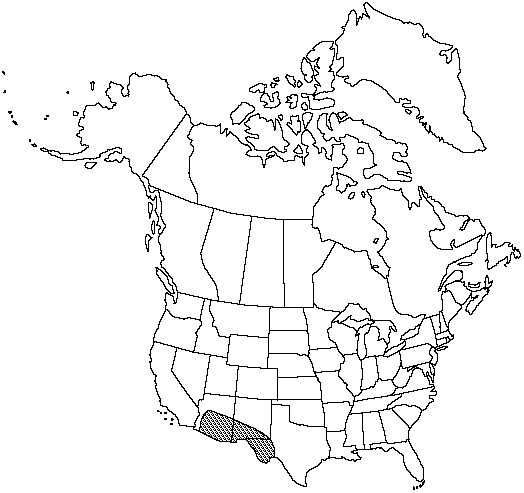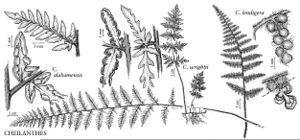FNA>Volume Importer |
FNA>Volume Importer |
| Line 17: |
Line 17: |
| | }}<!-- | | }}<!-- |
| | | | |
| − | --><span class="statement" id="st-d0_s0" data-properties="stem growth form or orientation;stem diameter"><b>Stems </b>long-creeping, 1–3 mm diam.;</span> <span class="statement" id="st-d0_s1" data-properties="scale coloration;scale coloration;scale shape;scale course;scale arrangement or shape;scale fixation or orientation;scale duration;portion life cycle">scales uniformly brown or slightly darker at base, linear-lanceolate, straight to slightly contorted, loosely appressed, often deciduous on older portions of stem.</span> <span class="statement" id="st-d0_s2" data-properties=""><b>Leaves </b>clustered to somewhat scattered, 4–25 cm;</span> <span class="statement" id="st-d0_s3" data-properties="leaf arrangement;leaf arrangement;leaf some measurement;leaf vernation">vernation circinate.</span> <span class="statement" id="st-d0_s4" data-properties="petiole coloration;petiole architecture"><b>Petiole </b>brown, grooved adaxially.</span> <span class="statement" id="st-d0_s5" data-properties="blade shape;blade shape;blade shape;blade shape;blade width"><b>Blade </b>lanceolate to ovate-deltate, 2-pinnate-pinnatifid at base, 1–4 cm wide;</span> <span class="statement" id="st-d0_s6" data-properties="rachis architecture;rachis pubescence;rachis pubescence">rachis grooved adaxially, not scaly or pubescent.</span> <span class="statement" id="st-d0_s7" data-properties="pinna architecture;pinna coloration;basal pinna size;basal pinna architecture or shape;basal pinna pubescence"><b>Pinnae </b>not articulate, dark color of stalk continuing into pinna base, basal pair often slightly larger than adjacent pair, ± equilateral, appearing glabrous adaxially.</span> <span class="statement" id="st-d0_s8" data-properties="costa length"><b>Costae </b>green adaxially for most of length;</span> <span class="statement" id="st-d0_s9" data-properties="abaxial scale count">abaxial scales absent.</span> <span class="statement" id="st-d0_s10" data-properties="ultimate segment shape;ultimate segment shape;ultimate segment shape;ultimate segment shape;ultimate segment size;ultimate segment some measurement;ultimate segment pubescence"><b>Ultimate </b>segments oblong to linear, not beadlike, the largest 3–7 mm, abaxially and adaxially glabrous.</span> <span class="statement" id="st-d0_s11" data-properties="false indusium position;false indusium variability;false indusium width"><b>False </b>indusia marginal, slightly differentiated, 0.05–0.25 mm wide.</span> <span class="statement" id="st-d0_s12" data-properties="sorus architecture or arrangement;sorus arrangement or density;lateral lobe architecture"><b>Sori </b>discontinuous, concentrated on interrupted lateral lobes.</span> <span class="statement" id="st-d0_s13" data-properties="spore count"><b>Sporangia </b>containing 64 spores.</span> <span class="statement" id="st-d0_s14" data-properties="2n chromosome count">2n = 60.</span><!-- | + | --><span class="statement" id="st-undefined" data-properties=""><b>Stems </b>long-creeping, 1–3 mm diam.; scales uniformly brown or slightly darker at base, linear-lanceolate, straight to slightly contorted, loosely appressed, often deciduous on older portions of stem. <b>Leaves</b> clustered to somewhat scattered, 4–25 cm; vernation circinate. <b>Petiole</b> brown, grooved adaxially. <b>Blade</b> lanceolate to ovate-deltate, 2-pinnate-pinnatifid at base, 1–4 cm wide; rachis grooved adaxially, not scaly or pubescent. <b>Pinnae</b> not articulate, dark color of stalk continuing into pinna base, basal pair often slightly larger than adjacent pair, ± equilateral, appearing glabrous adaxially. <b>Costae</b> green adaxially for most of length; abaxial scales absent. <b>Ultimate</b> segments oblong to linear, not beadlike, the largest 3–7 mm, abaxially and adaxially glabrous. <b>False</b> indusia marginal, slightly differentiated, 0.05–0.25 mm wide. <b>Sori</b> discontinuous, concentrated on interrupted lateral lobes. <b>Sporangia</b> containing 64 spores. <b>2n</b> = 60.</span><!-- |
| | | | |
| | -->{{Treatment/Body | | -->{{Treatment/Body |
| | + | |phenology=Sporulating summer–fall. |
| | |habitat=Rocky slopes and ledges usually on igneous substrates | | |habitat=Rocky slopes and ledges usually on igneous substrates |
| | |elevation=300–2000 m | | |elevation=300–2000 m |
| Line 39: |
Line 40: |
| | |basionyms= | | |basionyms= |
| | |family=Pteridaceae | | |family=Pteridaceae |
| | + | |phenology=Sporulating summer–fall. |
| | |habitat=Rocky slopes and ledges usually on igneous substrates | | |habitat=Rocky slopes and ledges usually on igneous substrates |
| | |elevation=300–2000 m | | |elevation=300–2000 m |
| Line 46: |
Line 48: |
| | |publication year=1858 | | |publication year=1858 |
| | |special status= | | |special status= |
| − | |source xml=https://jpend@bitbucket.org/aafc-mbb/fna-fine-grained-xml.git/src/287ef3db526bd807d435a3c7423ef2df1e951227/V2/V2_51.xml | + | |source xml=https://jpend@bitbucket.org/aafc-mbb/fna-data-curation.git/src/9216fc802291cd3df363fd52122300479582ede7/coarse_grained_fna_xml/V2/V2_51.xml |
| | |genus=Cheilanthes | | |genus=Cheilanthes |
| | |species=Cheilanthes wrightii | | |species=Cheilanthes wrightii |
| − | |2n chromosome count=60
| |
| − | |abaxial scale count=absent
| |
| − | |basal pinna architecture or shape=equilateral
| |
| − | |basal pinna pubescence=glabrous
| |
| − | |basal pinna size=often slightly larger than adjacent pair
| |
| − | |blade shape=2-pinnate-pinnatifid;lanceolate;ovate-deltate
| |
| − | |blade width=1cm;4cm
| |
| − | |costa length=green
| |
| − | |false indusium position=marginal
| |
| − | |false indusium variability=differentiated
| |
| − | |false indusium width=0.05mm;0.25mm
| |
| − | |lateral lobe architecture=interrupted
| |
| − | |leaf arrangement=scattered;clustered to somewhat
| |
| − | |leaf some measurement=4cm;25cm
| |
| − | |leaf vernation=circinate
| |
| − | |petiole architecture=grooved
| |
| − | |petiole coloration=brown
| |
| − | |pinna architecture=not articulate
| |
| − | |pinna coloration=dark color
| |
| − | |portion life cycle=older
| |
| − | |rachis architecture=grooved
| |
| − | |rachis pubescence=pubescent;not scaly
| |
| − | |scale arrangement or shape=contorted
| |
| − | |scale coloration=darker;brown
| |
| − | |scale course=straight
| |
| − | |scale duration=deciduous
| |
| − | |scale fixation or orientation=appressed
| |
| − | |scale shape=linear-lanceolate
| |
| − | |sorus architecture or arrangement=discontinuous
| |
| − | |sorus arrangement or density=concentrated
| |
| − | |spore count=64
| |
| − | |stem diameter=1mm;3mm
| |
| − | |stem growth form or orientation=long-creeping
| |
| − | |ultimate segment pubescence=glabrous
| |
| − | |ultimate segment shape=not beadlike;oblong;linear
| |
| − | |ultimate segment size=largest
| |
| − | |ultimate segment some measurement=3mm;7mm
| |
| | }}<!-- | | }}<!-- |
| | | | |
| | -->[[Category:Treatment]][[Category:Cheilanthes]] | | -->[[Category:Treatment]][[Category:Cheilanthes]] |
Stems long-creeping, 1–3 mm diam.; scales uniformly brown or slightly darker at base, linear-lanceolate, straight to slightly contorted, loosely appressed, often deciduous on older portions of stem. Leaves clustered to somewhat scattered, 4–25 cm; vernation circinate. Petiole brown, grooved adaxially. Blade lanceolate to ovate-deltate, 2-pinnate-pinnatifid at base, 1–4 cm wide; rachis grooved adaxially, not scaly or pubescent. Pinnae not articulate, dark color of stalk continuing into pinna base, basal pair often slightly larger than adjacent pair, ± equilateral, appearing glabrous adaxially. Costae green adaxially for most of length; abaxial scales absent. Ultimate segments oblong to linear, not beadlike, the largest 3–7 mm, abaxially and adaxially glabrous. False indusia marginal, slightly differentiated, 0.05–0.25 mm wide. Sori discontinuous, concentrated on interrupted lateral lobes. Sporangia containing 64 spores. 2n = 60.
Phenology: Sporulating summer–fall.
Habitat: Rocky slopes and ledges usually on igneous substrates
Elevation: 300–2000 m
Distribution
Ariz., N.Mex., Tex., n Mexico.
Discussion
The glabrous Cheilanthes wrightii is occasionally confused with C. alabamensis and certain species of Pellaea. Cheilanthes wrightii is easily separated from C. alabamensis by its glabrous rachis, which is grooved on the adaxial surface. It is distinguished from all local members of Pellaea by having both a grooved rachis and a thin, long-creeping stem.
Selected References
None.

